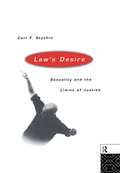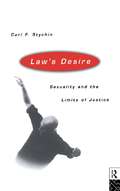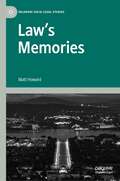- Table View
- List View
The Lawbreaker: A Critical Study of the Modern Treatment of Crime (Routledge Revivals)
by E. Roy Calvert Theodora CalvertThe early 21st century saw better prison conditions and a lower imprisonment rate however public worry over supposed increasing violent crime as perpetuated by the media in the 1930’s led to a return to harsher sentences and fuller prisons. Originally published in 1933, The Lawbreaker analyses British penal methods of the time and of the past to discover the most effective ways to treat prisoners and reduce crime as well as identifying where more research is needed to obtain a balance between punishment and rehabilitation. This title will be of interest to students of Criminology and Sociology.
The Lawbreaker: A Critical Study of the Modern Treatment of Crime (Routledge Revivals)
by E. Roy Calvert Theodora CalvertThe early 21st century saw better prison conditions and a lower imprisonment rate however public worry over supposed increasing violent crime as perpetuated by the media in the 1930’s led to a return to harsher sentences and fuller prisons. Originally published in 1933, The Lawbreaker analyses British penal methods of the time and of the past to discover the most effective ways to treat prisoners and reduce crime as well as identifying where more research is needed to obtain a balance between punishment and rehabilitation. This title will be of interest to students of Criminology and Sociology.
Lawful Order: A Case Study of Correctional Crisis and Reform (Current Issues in Criminal Justice)
by Leo CarrollFirst published in 1999. Routledge is an imprint of Taylor & Francis, an informa company.
Lawful Order: A Case Study of Correctional Crisis and Reform (Current Issues in Criminal Justice #Vol. 23)
by Leo CarrollFirst published in 1999. Routledge is an imprint of Taylor & Francis, an informa company.
Lawrence Kohlbergs Theorie des moralischen Urteilens: Eine wissenschaftstheoretische und forschungspraktische Analyse (Beiträge zur psychologischen Forschung #10)
by Ulf PeltzerDie vorliegende Arbeit entstand als Habilitationsschrift im Rahmen eines Forschungsprojektes am Lehrstuhl für Psychologie von Prof. Dr. H.A. Hartmann an der Wirtschafts- und Sozialwis senschaftlichen Fakultät der Universität Augsburg. Prof. Dr. H.A. Hartmann und Prof. Den Referenten der Arbeit, Dr. R. Wakenhut, danke ich für ihre Geduld und wohlwollende Zu Dank verpflichtet bin ich auch Dr. R. Haubl Unterstützung. und Dr. L. Kern für ihre kritischen Kommentare zum Manuskript und Frau U. Boehnke, Frau A. Lie und Frau I. Schmucker für das - nicht immer einfache - Schreiben des Textes. Augsburg, Mai 1976 Ulf Peltzer Inhaltsverzeichnis 1. Einleitung .................................... . 1 1.1 Bedeutung der Kohlbergsehen Theorie 1 Eingrenzung der Fragestellung und 1.2 Beurteilungsperspektive ....................... . 3 Überblick über die Arbeit ..................... . 6 1.3 2. Schwierigkeiten für die Rezeption von Kohlbergs Theorie ......................... . 8 8 2.1 Revisionen der Theorie ........................ . 2.2 Forschungsdokumentation ....................... . 12 Widersprüche in den Veröffentlichungen ........ . 15 2.3 2.4 Fazit ......................................... . 21 3. Die wissenschaftstheoretische Position von Kohlberg . . . . . . . . . . . . . . . . . . . . . . . . . . . 23 . . . . . . . . 3.1 Idealtypen-Analyse ............................ . 23 3.2 Abduktion und "mutual bootstrapping" .......... . 23 3.3 Rationale Rekonstruktion der Ontogenese ....... . 28 3.4 Philosophische Hintergrundstheorie ............ . 32 3.5 Fazit ......................................... . 51 4. Die inhaltliche Theorie von Kohlberg .......... . 56 4.1 56 Theorie-Kern .................................. .
Laws And Explanation In The Social Sciences: Defending A Science Of Human Behavior
by Lee C McintyreThe first full-length defense of social scientific laws to appear in the last twenty years, this book upholds the prospect of the nomological explanation of human behavior against those who maintain that this approach is impossible, impractical, or irrelevant. By pursuing an analogy with the natural sciences, Mclntyre shows that the barriers to nomological inquiry within the social sciences are not generated by factors unique to social inquiry, but arise from a largely common set of problems that face any scientific endeavor. All of the most widely supported arguments against social scientific laws have failed largely due to adherence to a highly idealized conception of nomologicality (allegedly drawn from the natural sciences themselves) and the limited doctrine of "descriptivism." Basing his arguments upon a more realistic view of scientific theorizing that emphasizes the pivotal role of "redescription" in aiding the search for scientific laws, Mclntyre is optimistic about attaining useful law-like explanations of human behavior.
Law's Desire: Sexuality And The Limits Of Justice
by Carl StychinThis book is about the relationship between law and desire. More specifically, it is about how sexual desires are constituted and regulated by the law, with particular reference to gay male and, to a lesser extent, lesbian and bisexual sexualities. I attempt to uncover what the law desires- which, I will argue, is the 'homosexual', against whom a coherent heterosexuality can be promoted through law. Throughout the book, I seek to demonstrate that the relationship of law and sexuality is complex and dynamic. While law may be (and has been) a repressive force, it also is a regulatory one which plays a role in constituting and maintaining coherent sexualities. At the same time, regulation is never entirely successful, for gaps and inconsistencies are left within legal discourse. This creates spaces for resistance against, and opposition to, the legal and sexual hegemony. I hope that this book provides one such intervention.
Law's Desire: Sexuality And The Limits Of Justice
by Carl StychinThe law is one of the primary means through which sexuality is constructed, monitored and controlled. In this much needed book, Carl Stychin provides a critical examination of the relationship between law and sexual orientation in the United States, the United Kingdom and Canada. The author exposes the connection between the law and sexual control through an exploration of key questions of current interest and controversy. He examines the motivations behind legal restrictions, and the impact on sexual subcultures and dominant society.
Law's Desire: Sexuality And The Limits Of Justice
by Carl StychinThe law is one of the primary means through which sexuality is constructed, monitored and controlled. In this much needed book, Carl Stychin provides a critical examination of the relationship between law and sexual orientation in the United States, the United Kingdom and Canada. The author exposes the connection between the law and sexual control through an exploration of key questions of current interest and controversy. He examines the motivations behind legal restrictions, and the impact on sexual subcultures and dominant society.
Law's Desire (PDF): Sexuality And The Limits Of Justice
by Carl StychinThis book is about the relationship between law and desire. More specifically, it is about how sexual desires are constituted and regulated by the law, with particular reference to gay male and, to a lesser extent, lesbian and bisexual sexualities. I attempt to uncover what the law desires- which, I will argue, is the 'homosexual', against whom a coherent heterosexuality can be promoted through law. Throughout the book, I seek to demonstrate that the relationship of law and sexuality is complex and dynamic. While law may be (and has been) a repressive force, it also is a regulatory one which plays a role in constituting and maintaining coherent sexualities. At the same time, regulation is never entirely successful, for gaps and inconsistencies are left within legal discourse. This creates spaces for resistance against, and opposition to, the legal and sexual hegemony. I hope that this book provides one such intervention.
Law’s Memories (Palgrave Socio-Legal Studies)
by Matt HowardThis book discusses the relationship between law and memory and explores the ways in which memory can be thought of as contributing to legal socialization and legal meaning-making. Against a backdrop of critical legal pluralism which examines the distributedness of law(s), this book introduces the notion of mnemonic legality. It emphasises memory as a resource of law rather than an object of law, on the basis of how it substantiates senses of belonging and comes to frame inclusions and exclusions from a national community on the basis of linear-trajectory and growth narratives of nationhood. Overall, it explores the sensorial and affective foundations of law, implicating memory and perceptions of belonging within this process of creating legality and legitimacy. By identifying how memory comes to shape and inform notions of law, it contributes to legal consciousness research and to important questions informing much socio-legal research.
Law's Premises, Law's Promise: Jurisprudence After Wittgenstein
by Thomas MorawetzThis title was first published in 2000: The author is a legal and moral philosopher who has applied the insight and methods of Wittgenstein to a range of topics in constitutional law, criminal law and theories of justice. This collection offers his most important and influential essays, together with an introductory essay which reviews and develops his contribution to legal and moral philosophy.
Law's Premises, Law's Promise: Jurisprudence After Wittgenstein
by Thomas MorawetzThis title was first published in 2000: The author is a legal and moral philosopher who has applied the insight and methods of Wittgenstein to a range of topics in constitutional law, criminal law and theories of justice. This collection offers his most important and influential essays, together with an introductory essay which reviews and develops his contribution to legal and moral philosophy.
Lawyer Evaluation in Chinese Courtroom: A Social-Semiotic Perspective
by Liping ZhangThis book focuses on the speech style of lawyer talk in contemporary Chinese courtrooms. The topic is intriguing to readers who may wonder how lawyers compete with their opposing counterparts in an adversarial trial system in China. The legal tradition in Confucianism, which advocates harmony in interpersonal relationships, has historically guided the practice of law in China. The book analyses how lawyers manage to compete in this system. Applying the social semiotic view of language in the Hallidayian sense, specifically systemic functional linguistics and its appraisal theory, this study interprets the subjectivity of legal language by lawyers. The speech style in legal argument presentation is described as 'rational'. The exploration of the rational speech style of lawyers is a theoretical and discursive topic. It draws upon Habermasian philosophy of intersubjectivity in legal argumentation and considers the cultural and legal contexts of China as contextual constraints. The keyconstruct of lawyer evaluation is fully captured in this discussion. As a linguistic phenomenon and unit of analysis, discourse can be examined both within local clauses and in larger stretches of talk beyond clauses. Additionally, it serves as an effective means for constructing a rational speech style for lawyers. Most importantly, discourse is a discursive act that negotiates legal arguments in the dynamic speech exchanges of a court trial, which is embedded in a wider social and cultural context. The book showcases instances of lawyer talk in well-documented trials in China and offers a good opportunity for readers to gain a general understanding of courtroom discourse in the Chinese context. It introduces readers with special interests in legal language and the law to the solidarity dimension of legal language and arguments, an alternative to the confrontational or hostile lawyer talk in trials in countries with a common-law system. The analysis presented is refined and the language used is clear, concise, and objective.
Lawyers and Mediation
by Bryan ClarkThis book charts the historical and current interaction between lawyers and mediation in both the common law and civil law world and analyses a number of issues relevant to lawyers’ part in the process. Lawyers have in the past and continue to play many roles in the context of mediation. While some are champions for the process, many remain on the fringes and apathetic, while others are openly sceptical or even anti-mediation in their stance. Yet others may have embraced mediation but, it is argued, for cynical, disingenuous reasons. By reviewing existing empirical evidence on lawyers’ interactions with mediation and by examining historical and current trends in lawyers’ dalliance with mediation, this book seeks to shed new light on a number of related issues, including: lawyers’ resistance to mediation; lawyers’ motives for involvement with mediation; the appropriateness of lawyers acting as mediators and party representatives; and the impact that both lawyers and the increasing institutionalisation of mediation have had on the normative form of the process, as well as the impact that mediation experience heralds for lawyers and legal systems in general.
Lay Theories: Everyday Understanding of Problems in the Social Sciences (International Series in Experimental Social Psychology #Volume 17)
by Michael ArgyleLay theories - the informal, common-sense explanations people give for particular social behaviours - are often very different from formal 'scientific' explanations of what actually happens. While they have been studied in the past, this is the first attempt to review, in detail, the nature of these beliefs. More specifically, it is the first study to consider such fundamental questions as the structure, aetiology, stability and consequence of lay theories about a range of topics. Each chapter covers a different area, such as psychology, psychiatry, medicine, economics, statistics, law and education.
Laypeople in Law: Socio-Legal Perspectives on Non-Professionals
by Andrea KretschmannThis book contributes to a better understanding of the role laypeople hold in the social functioning of law.It adopts the scholarly insight that the law is unthinkable without an everyday legal understanding of the law pursued by laypeople. It engages with the assumption that not only the law’s existence but also its development is shaped by the layperson’s affirmations, oppositions, ignorance, or negations of the law. This volume thus aims to fill a void in socio-legal studies. Whereas many sociolegal theories tend to conceptualize the law through legal experts’ actions, institutions, procedures, and codifications, it argues that such a viewpoint underestimates the role of laypeople in the law’s processing and advocates for a strengthened conceptual place in socio-legal theory.This book will appeal to socio-legal scholars and sociologists (of law), as well as to legal practitioners and laypersons themselves.
Laypeople in Law: Socio-Legal Perspectives on Non-Professionals
This book contributes to a better understanding of the role laypeople hold in the social functioning of law.It adopts the scholarly insight that the law is unthinkable without an everyday legal understanding of the law pursued by laypeople. It engages with the assumption that not only the law’s existence but also its development is shaped by the layperson’s affirmations, oppositions, ignorance, or negations of the law. This volume thus aims to fill a void in socio-legal studies. Whereas many sociolegal theories tend to conceptualize the law through legal experts’ actions, institutions, procedures, and codifications, it argues that such a viewpoint underestimates the role of laypeople in the law’s processing and advocates for a strengthened conceptual place in socio-legal theory.This book will appeal to socio-legal scholars and sociologists (of law), as well as to legal practitioners and laypersons themselves.
Le monde social selon Husserl (Phaenomenologica #209)
by Laurent PerreauCette étude est consacrée à l'examen de la théorie du monde social qui se découvre dans la phénoménologie d’Edmund Husserl : est-elle à même de dire les phénomènes sociaux, sur quel mode et avec quels résultats ?Dans un premier moment, nous reconstituons le propos des deux « ontologies sociales » qui pensent le monde social en son essence et en ses essences : d’une part, l'ontologie de la région « monde social », subordonnée à la région de l'« esprit » et élaborée à partir d'une phénoménologie de la communication ; d’autre part, l'ontologie morphologique et eidétique des formes essentielles de communautés sociales. Dans un second moment, nous suivons l'élaboration d'une « sociologie transcendantale » qui reconsidère le rapport de la subjectivité transcendantale au monde social. Nous montrons comment les développements de la théorie de la personne dans la perspective de la phénoménologie génétique, qui semblent nous détourner de la considération de sa socialité, précisent en réalité le rapport du sujet personnel au monde social sous l'angle de sa « mienneté », de l'habitualité et de la familiarité d'une part, et dans la perspective d'une éthique sociale d'autre part. On établit enfin comment, autour de la Krisis, la théorie du monde de la vie fournit le cadre théorique d'une « sociologie transcendantale » qui se développe, sur le fond d'une anthropologie du monde commun, comme théorie de la générativité. De l'ontologie sociale à la sociologie transcendantale, cette recherche est conçue comme une investigation des ressources et des difficultés de la voie par l'ontologie d'accès à la réduction transcendantale, relativement à la question du « social ».Remarquable enquête menée sur l'expérience sociale du sujet, la phénoménologie husserlienne du monde social est susceptible d’intéresser le sociologue comme le philosophe qui s’interroge sur la nature du « social » en général.
Le Play: Engineer and Social Scientist
by Michael BrookeA study and assessment of the career of Frederic Le Play (1806-1882), now recognised as a founder of modern sociology. The main theme consists of a detailed and impartial analysis of Le Play's thoughts on the relationship between society and technology. His contributions to fields other than sociology are also considered.
Le Play: Engineer and Social Scientist
by Michael Z. BrookeA study and assessment of the career of Frederic Le Play (1806-1882), now recognised as a founder of modern sociology. The main theme consists of a detailed and impartial analysis of Le Play's thoughts on the relationship between society and technology. His contributions to fields other than sociology are also considered.
Le Travail et ses Representations
by Michel CartierFirst Published in 1984. From Adam Smith to Karl Marx, classical economists identify work as a collection of technical operations resulting in the creation of social goods and founding value. The authors of this book deal with several societies in Asia, Africa and America. D'Adam Smith a Karl Marx, les economistes classiques identifient le travail a un emsemble d'operations techniques aboutissant a la creation de biens sociaux et fondant la valeur. Les auters de ce livre traitent de plusieurs societes d'Asie, d'Afrique at d'Amerique.
Le Travail et ses Representations
by Michel CartierFirst Published in 1984. From Adam Smith to Karl Marx, classical economists identify work as a collection of technical operations resulting in the creation of social goods and founding value. The authors of this book deal with several societies in Asia, Africa and America. D'Adam Smith a Karl Marx, les economistes classiques identifient le travail a un emsemble d'operations techniques aboutissant a la creation de biens sociaux et fondant la valeur. Les auters de ce livre traitent de plusieurs societes d'Asie, d'Afrique at d'Amerique.
Lead and Disrupt: How to Solve the Innovator's Dilemma, Second Edition
by Michael L. Tushman Charles A. O’Reilly IIIFully revised, this second edition offers a proven strategy for using ambidexterity to build discontinuous growth for mature organizations, and the flexibility to adapt in fast-changing environments. Why do successful firms find it so difficult to adapt in the face of change – to innovate? In the past ten years, the importance of this question has increased as more industries and firms confront disruptive change. The pandemic has accelerated this crisis, collapsing the structures of industries from airlines and medicine to online retail and commercial real estate. Today, leaders in business have an obligation not only to investors but to their employees and communities. At the core of this challenge is helping their organizations to survive in the face of change. The original edition summarized the lessons that the authors as researchers and consultants had learned over the previous two decades. Since then, they have continued to work with leaders of organizations around the world confronting disruptive change. With updates to every chapter, including new examples and analysis, this fully revised edition incorporates the lessons and insights that the authors have gained in the past five years. Two new chapters critically examine the role of organizational culture in promoting or hindering ambidexterity and its underlying fundamental disciplines. Using examples from firms such as Microsoft, General Motors, and Amazon, O'Reilly and Tushman illustrate how leaders can align their organization's cultures to fit the needed strategy, and how ideation, incubation, and scaling approaches, when used altogether, can successfully develop new growth businesses.
Lead and Disrupt: How to Solve the Innovator's Dilemma
by Michael L. Tushman Charles A. O’Reilly IIIIn the past few years, a number of well-known firms have failed; think of Blockbuster, Kodak, or RadioShack. When we read about their demise, it often seems inevitable—a natural part of "creative destruction." But closer examination reveals a disturbing truth: Companies large and small are shuttering more quickly than ever. What does it take to buck this trend? The simple answer is: ambidexterity. Firms must remain competitive in their core markets, while also winning in new domains. Innovation guru Clayton M. Christensen has been pessimistic about whether established companies can prevail in the face of disruption, but Charles A. O'Reilly III and Michael L. Tushman know they can! The authors explain how shrewd organizations have used an ambidextrous approach to solve their own innovator's dilemma. They contrast these luminaries with companies which—often trapped by their own successes—have been unable to adapt and grow. Drawing on a vast research program and over a decade of helping companies to innovate, the authors present a set of practices to guide firms as they adopt ambidexterity. Top-down and bottom-up leaders are key to this process—a fact too often overlooked in the heated debate about innovation. But not in this case. Readers will come away with a new understanding of how to improve their existing businesses through efficiency, control, and incremental change, while also seizing new markets where flexibility, autonomy, and experimentation rule the day.
















